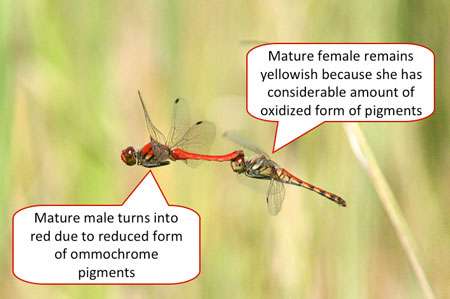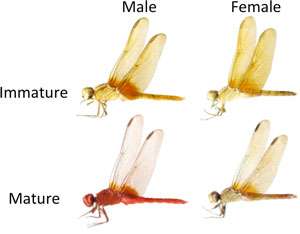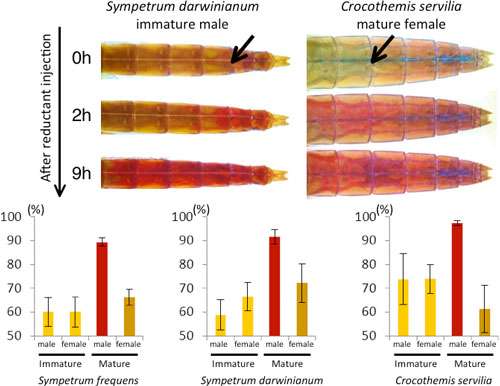Researchers discover molecular basis for body-color change in red dragonflies

Japanese researchers have discovered that the body color of the red dragonflies changes from yellow to red through redox reaction of pigments called ommochromes.
Both male and female red dragonflies are yellow in the immature adult stage, but males turn into red upon maturation. This is due to the change of oxidized ommochrome pigments into reduced forms. Redox-based dramatic body color change has not been reported before. Cells that change into red are in the antioxidant state due to the presence of the reduced form pigments. Further investigation of the molecular mechanisms of this body color change should help us to understand how the antioxidant state is maintained in organisms.
This study was published online in Proceedings of the National Academy of Sciences on July 10, 2012 (JST).

Beautiful red dragonflies are mature males, while females and newly emerged immature males are dull yellow in color. The different body colors of males and females play important roles in partner recognition before mating and territorial behavior. Several mechanisms have been reported for body color changes in insects and other animals, such as synthesis and degradation of pigments, changes in localization of pigments, and accumulation of pigments from food. However, the mechanisms underlying the body color change in red dragonflies have been unknown.
AIST has been investigating the sophisticated biological functions of insects for adaption to various environments, one of which is the mechanism of body color underlying their important ecological feature. Many dragonfly species drastically change their body color upon adult maturation, but molecular mechanisms underlying the process are unknown. In this study, the mechanisms underlying the body color change in red dragonflies are investigated.
Pigments present in three species of red dragonfly, namely the autumn darter (Sympetrum frequens), the summer darter (Sympetrum darwinianum),and the scarlet skimmer (Crocothemis servilia), were extracted and characterized. Two different ommochrome pigments (xanthommatin and decarboxylated xanthommatin) were commonly identified in all these species.
Previous studies have reported that the color of ommochrome pigments changes reversibly by redox reactions in vitro. In this study, when an oxidant or reductant was added, the color of the pigments extracted from the red dragonflies changed reversibly, from red to yellow in the presence of the oxidant and from yellow to red in the presence of the reductant. In addition, when ascorbic acid (vitamin C), a reductant, was injected into live dragonflies, the yellowish body color of both immature males and mature females changed into red as observed in mature males. Redox conditions of the pigments extracted from the dragonflies were electrochemically measured and the ratios of the oxidized and reduced pigments were quantified. Only the mature males exhibited very high proportions of the reduced ommochrome pigments. These results indicate that sex-specific color change in mature red dragonflies is primarily regulated by redox states of the ommochrome pigments.

Accumulation of water-soluble antioxidants (reducing agents) like ascorbic acid is often observed in plants. Such antioxidants may be synthesized and/or accumulated in mature males of the red dragonflies and involved in reduction of the ommochrome pigments. By measuring antioxidant activities in water extracts from the epidermis of the dragonflies, stronger antioxidant activities were detected in mature males than mature females. Further analysis revealed that the reduced ommochrome pigments are the major components of the antioxidant present in these males.
Male-specific color change of dragonflies has been considered as an ecologically important trait for reproductive success. The results of this study suggest that the coloration may play another biological role: strong antioxidant ability in mature males may be relevant to their territorial behavior under the scorching sun to reduce oxidative stress from ultraviolet radiation.
A previously unknown mechanism in animals, namely a body color change of red dragonflies by redox reaction of the pigments, has been elucidated. Red mature males exhibited antioxidant state, and since this red color is maintained for a long time even in dried specimens, there may be some mechanism that maintains the pigments reduced. Further investigation may lead to a new understanding of antioxidation mechanism.
The researchers will perform comprehensive gene expression analyses using next-generation sequencing techniques to investigate the molecular mechanisms underlying the body color change in the red dragonflies. Through such approaches, the mechanisms as to how the pigments are efficiently altered into the reduced form and how the antioxidant state of the pigments is maintained are to be understood, which would lead to the development of useful natural antioxidants.
Journal information: Proceedings of the National Academy of Sciences
Provided by Advanced Industrial Science and Technology
















